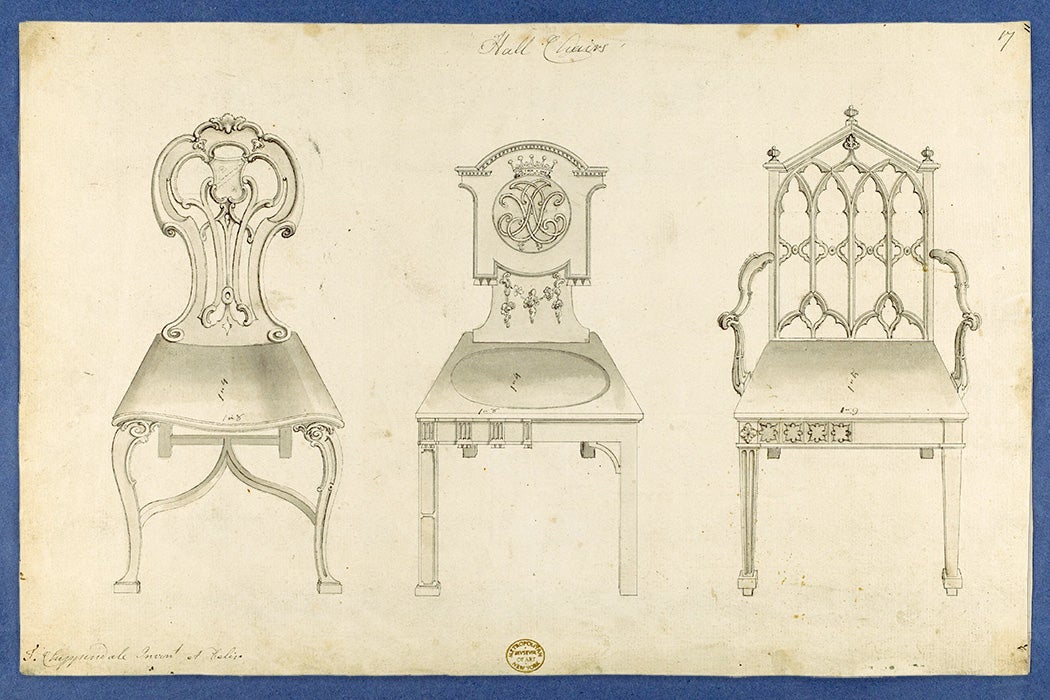There are at least two statues of the furniture maker Thomas Chippendale (1718–1779). One is in his birthplace of Otley, Yorkshire. The other is on the exterior of the Victoria and Albert Museum in London, amid the pantheon of artists, designers, and craftsmen memorialized as Britain’s finest. This is doubly impressive, since nobody knows what he really looked like.
The V&A apotheosis in stone is fitting, since Chippendale, the “Shakespeare of English Furniture,” is still one of he most recognizable names in the history of furniture-making. As scholar Megan Aldrich writes, it’s also symptomatic of the mythology that grew around him, especially more than century after his death.
“Chippendale is presented as a bearded, imposing, almost heroic figure with overtones of Michaelangelo [sic] in his posture and bearing,” explains Aldrich. “In common with William Shakespeare, no reliable image of Thomas Chippendale exists, and Hodge has presented him as an idealized figure in the Italian Renaissance tradition.”
Albert Hodge’s V&A statue dates to 1905, when Chippendale’s stature was at its peak. Not that his stature has fallen much in the century-plus since: Chippendale is the gold standard in antique furniture—not least because his famous pattern book The Gentleman and Cabinet Maker’s Director, first published in 1754, inspired furniture makers from Philadelphia to Copenhagen. Essentially a catalog, the first edition of the Director had 160 designs for such household furniture as sofas, chairs, beds, writing tables, and bookcases. It was the first large scale publication of its kind.
Some of the basic facts of Chippendale’s life remain unknown, and confusion set in early when he was confused with an unrelated Thomas Chippendale, a frame-maker from Worcestershire who came to London in 1727. The more famous Thomas Chippendale got started in London at a later date—records show he moved to a large workshop, employing as many as fifty skilled craftsmen, in St Martin’s Lane in 1753/54. Because of the confusion with this other Chippendale, Chippendale’s Director was taken as a mid-career work and considered “representative of his furniture” through the first quarter of the twentieth century.
In fact, as Aldrich writes, the earliest “firmly documented furniture produced in [Chippendale’s] workshop can be dated to 1757,” after the second edition of the Director was published. The famous pattern book doesn’t, it turns out, “reflect his mature work.”
In addition, Thomas Chippendale, Junior carried on the family business until his death in 1822, creating more confusion about who actually made what under the Chippendale name. Meanwhile, the styles—Rococo, Neoclassical, Chinoiserie—inspired by the Director were taken up by furniture makers across Europe and in America, turning Chippendale into an “international design phenomenon.” Not that there were any licensing rights for Chippendale himself.

Consider the iconic ribbon-back chair, “universally recognized as the quintessential ‘Chippendale chair.’” This Museum of Fine Arts, Boston example is an epitome of its kind. Based on the Director pattern, it was made in Salem, Massachusetts, around 1770. Such chairs were also reproduced frequently in the late nineteenth and early twentieth centuries. More than a few of these made it into collections, including museums, as genuine Chippendales, even though, as Aldrich notes, “there exists no firmly authenticated example from Chippendale’s workshop.”
Weekly Newsletter
An acknowledged reproduction is one thing, but outright fakes made for the market created morasses of attribution and provenance. A notable 1923 British lawsuit over fake furniture, including alleged Chippendales, brought the issues into the limelight. In the aftermath of that court case, Herbert Cescinsky’s The Gentle Art of Faking Furniture (1931) made great strides in separating the man Chippendale from the myth Chippendale.
It was Cescinsky who finally figured out when Chippendale actually arrived in London, circa 1748. Cescinsky went too far, Aldrich believes, in calling the Director designs unoriginal, but nevertheless he helped give birth to modern Chippendale studies.
Support JSTOR Daily! Join our new membership program on Patreon today.







